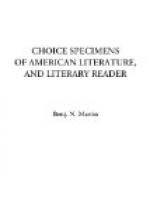Here, where we are, said the postillion, “was the first battle; but there was another, two years afterwards, over there, the other side of Trogen, where the road goes down to the Rhine. Stoss is the place, and there’s a chapel built on the very spot. Duke Frederick of Austria came to help the Abbott Runo, and the Appenzellers were only one to ten against them. It was a great fight, they say, and the women helped,—not with pikes and guns, but in this way: they put on white shirts, and came out of the woods, above where the lighting was going on. Now when the Austrians and the Abbot’s people saw them, they thought there were spirits helping the Appenzellers, (the women were all white you see, and too far off to show plainly,) and so they gave up the fight, after losing nine hundred knights and troopers. After that, it was ordered, that the women should go first to the sacrament, so that no man might forget the help they gave in that battle. And the people go every year to the chapel, on the same day when it took place.”
If one could only transport—a few of these houses to the United States! Our country architecture is not only hideous, but frequently unpractical, being at worst, shanties, and at best, city residences set in the fields. An Appenzell farmer lives in a house from forty to sixty feet square, and rarely less than four stories in height. The two upper stories, however, are narrowed by the high, steep roof, so that the true front of the house is one of the gables. The roof projects at least four feet on all sides, giving shelter to balconies of carved wood, which cross the front under each row of windows. The outer walls are covered with upright, overlapping shingles, not more than two or three inches broad, and rounded at the ends, suggesting the scale armor of ancient times. This covering secures the greatest warmth; and when the shingles have acquired from age that rich burnt-sienna tint—which no paint could exactly imitate, the effect is exceedingly beautiful. The lowest story is generally of stone, plastered and whitewashed. The stories are low, (seven to eight feet) but the windows are placed side by side, and each room is thoroughly lighted. Such a house is very warm, very durable, and, without any apparent expenditure of ornament, is externally so picturesque that no ornament could improve it....
The view of a broad Alpine landscape dotted all over with such beautiful homes, from the little shelf of green hanging on the sides of a rocky gorge, and the strips of sunny pasture between the ascending forests, to the very summits of the lower heights and the saddles between them, was something quite new in my experience.
* * * * *
NOVELISTS AND WRITERS OF FICTION.
=_Charles Brockden Brown, 1771-1810._= (Manual, pp. 478, 505.)
From “Ormond.”
=_276._= THE YELLOW FEVER IN PHILADELPHIA.




